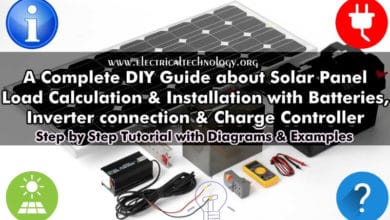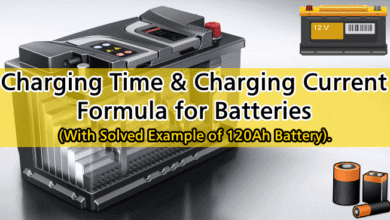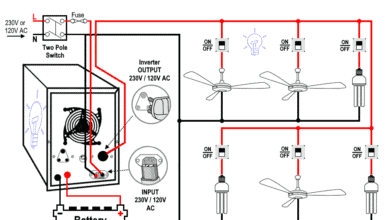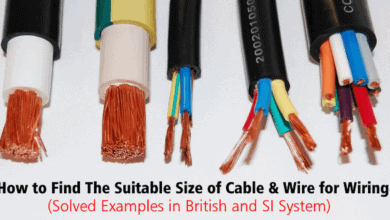How to Size Equipment Grounding Conductor (EGC)?
What is Equipment Grounding Conductor? Sizing EGC for Grounding Systems
The Equipment Grounding Conductor (EGC) is a main part of the electrical bonding and grounding system, ensuring the safe dissipation of fault currents. It protects both people from electric shock and equipment from damage. The sizing of the EGC is governed by Article 250.122 of the NEC and is determined based on the rating of the overcurrent protection device (OCPD).
For a proper grounding system, the following step-by-step guide can be used to determine the suitable size of Equipment Grounding Conductor (EGC) based on NEC 2023 (Article 250.122 and Table 250.122).
What is EGC?
The equipment grounding conductor (EGC) is an essential component of an electrical grounding system that provides a low-impedance path for fault currents. It is used to bond all non-current-carrying metallic parts of electrical equipment to the grounding system, ensuring safety and proper operation of overcurrent protective devices and circuits.
According to the National Electrical Code (NEC), an Equipment Grounding Conductor (EGC) is a conductive path designed to carry ground-fault currents. It connects normally noncurrent-carrying metal parts of electrical equipment to the grounded conductor, the grounding electrode conductor, or both, ensuring a safe return path for fault currents.
In a solidly grounded system, a main bonding jumper (MBJ) is used to connect the equipment grounding conductor (EGC) to the neutral of the supply at a single point (e.g., in the main panel or disconnect). This connection ensures that in the event of a fault, especially when a phase (hot) conductor accidentally contacts an exposed metallic part of the equipment, the fault current can flow through a low-impedance path via the EGC, equipment grounding conductor, and grounding electrode to the physical earth. Hence, it minimize the risk of equipment damage and electric shock hazards to personnel.
The permitted and acceptable types of equipment grounding conductor are copper, aluminum, or copper-clad aluminum conductor. Additionally, rigid metal conduit, intermediate or flexible metal conduit, electrical metallic tubing can also be used as EGC. NEC 250.118.
- Related Post: How to Size Grounding Electrode Conductor (GEC)?
Identification of EGC
equipment grounding conductor can be bare, covered, or insulated. Green or green with yellow stripe(s) are used as color codes for EGC.
Green colored or hexagon shaped terminal “G” is used for equipment grounding conductor (EGC) in receptacles and cords. The EGC terminal is labeled as “G,” “GR,” “GRN,”, “GRND” or “⏚” mark in accordance with NEC – 250.126 and 406.9(B).
The GEC must be identified by either having it stripped the entire accessible length, or to me marked / colored green at the termination or green adhesive labels at the termination. Refer to NEC – 250.119(A), 250.119 B (2) & C (1,2,3), 250.62 and 250.64.
Equipment grounding conductor (EGC) is also known as “Grounding Conductor”, “Equipment (EGC)” is used to perform bonding between electrical equipment.
In the U.S. (NEC), the Equipment Grounding Conductor (EGC) is referred to as the Earth Continuity Conductor in BS 7671 and IEC-compliant countries. The function and purpose are the same; only the terminology differs.
- All exposed metallic parts of equipment that are likely to become energized shall be connected to the grounding system using an equipment grounding conductor (EGC) in accordance with NEC Sections 250.104, 250.134, and 250.136.
- The equipment grounding conductor (EGC) should not carry electric current during the normal operation of the circuit.
- Never use the bare EGC as a neutral (grounded circuit conductor) or vice versa when using nonmetallic-sheathed or armored cable. The neutral and EGC are only bonded together at the main service panel, not in branch circuit wiring. (NEC 250.142).
- The equipment grounding conductor (EGC) should be connected to the neutral at only one point. Connecting the neutral to the EGC at multiple points can create ground loops, resulting in objectionable current flowing back to the source via the grounding electrode conductor (GEC) and within the circuit. This can lead to improper operation of ground-fault circuit interrupters (GFCIs) and residual current devices (RCDs).
Purpose of the EGC
The primary purpose of an Equipment Grounding Conductor (EGC) is to provide a reliable path for fault currents to return to the source and facilitate the operation of overcurrent protective devices such as circuit breakers and fuses. This ensures that in case of a fault, the excessive current is safely directed to the ground, preventing electric shock and fire hazards. This also applies for the same purpose of bonding of equipment using EGC. (NEC 250.4(A)(3)).
The Equipment Grounding Conductor (EGC) is sometimes confused with the Grounding Electrode Conductor (GEC). While both are grounding conductors, they serve different purposes.
- EGC (Equipment Grounding Conductor): Bonds the metallic components of electrical systems to the ground to provide a safe path for fault currents.
- GEC (Grounding Electrode Conductor): Connects the electrical system to the grounding electrode (such as ground rods) to stabilize the system voltage.
- The sizing of EGC is determined based on Article 250.122 and Table 250.122 of the NEC.
Related Post: How to Size the Earth Conductor, Earthing Lead & Earth Electrodes?
Sizing Equipment Grounding Conductor
The NEC 2023 provides guidelines for sizing the EGC based on the overcurrent protective device rating for the circuit.
According to NEC 2023, Section 250.122, the EGC must be sized based on the rating of the overcurrent protective device (OCPD) that protects the circuit conductors. The standard sizes are provided in Table 250.122.
To properly size an EGC, follow these steps:
- Determine the Overcurrent Protective Device (OCPD) Rating: This includes circuit breakers or fuses protecting the circuit.
- Identify the Circuit Conductor Material: Copper or Aluminum.
- Refer to NEC Table 250.122: This table provides the minimum size requirements for EGC based on the rating of the OCPD.
- Apply Adjustments for Special Conditions: In cases where conductors are installed in parallel, larger conductors may be required.
- The minimum required size of an Equipment Grounding Conductor (EGC) should not be less than 14 AWG copper or 12 AWG aluminum / copper-clade aluminum. NEC 250.122.
- The size of EGC does not need to be larger than the largest ungrounded conductor in a circuit. This is because the ground-fault current flowing through the EGC cannot exceed the current in the ungrounded conductor in case of fault. In other words, it follows Kirchhoff’s current law (KCL), similar to a series circuit. (NEC 250.122(A)).
Related Post: Design of Grounding / Earthing System in a Substation Grid
Special Conditions and Exceptions for EGC
There are special conditions where the EGC sizing may be affected:
- Parallel Conductors: When circuit conductors are installed in parallel, an individual EGC must be run with each set, and its size is based on the size of the largest ungrounded conductor in each parallel set. NEC 250.122(F).
- Equipment Bonding: When bonding metal raceways or enclosures, the EGC size must be at least as large as specified in Table 250.122 but may be increased if required by voltage drop considerations. An internal bonding strip shall not be used as a grounded neutral conductor or as a separate equipment grounding conductor.
- High-Fault Current Conditions: In industrial locations where available fault currents exceed 10,000 amperes, larger EGCs may be required to ensure the integrity of the grounding system.
EGC Sizing Table
The minimum size of the equipment grounding conductor (EGC) is determined using NEC Table 250.122. This table provides the minimum size of an EGC based on the rating of the overcurrent device (breaker or fuse).
| OCPD Rating | Copper EGC (AWG) | Aluminum or Copper-Clad Aluminum EGC (AWG) |
| 15 | 14 | 12 |
| 20 | 12 | 10 |
| 30 | 10 | 8 |
| 40 | 10 | 8 |
| 60 | 10 | 8 |
| 100 | 8 | 6 |
| 200 | 6 | 4 |
| 300 | 4 | 2 |
| 400 | 3 | 1 |
| 500 | 2 | 1/0 |
| 600 | 1 | 2/0 |
| 800 | 1/0 | 3/0 |
| 1000 | 2/0 | 4/0 |
| 1200 | 3/0 | 250 kcmil |
| 1600 | 4/0 | 350 kcmil |
| 2000 | 250 kcmil | 400 kcmil |
| 2500 | 350 kcmil | 600 kcmil |
| 3000 | 400 kcmil | 750 kcmil |
| 4000 | 500 kcmil | 1000 kcmil |
| 5000 | 700 kcmil | 1250 kcmil |
🔹Note: If the conductors are upsized for voltage drop compensation, the EGC must be proportionally increased as per 250.122(B).
Here is the EGC sizing table in the image format for reference.

- Related Post: Grounding and Methods of Earthing in PV Solar System
Examples of EGC Sizing and Calculations
Example 1: What is the suitable size of EGC for a 15 and 20 -Amp circuit breakers?
Solution:
The rating of overcurrent devices used for the most common household applications are 15-amp and 20-amp.
Refereeing to the NEC table 250.122;
For 15-Amp Circuit
- Copper EGC: 14 AWG
- Aluminum / Copper-Clad Aluminum EGC: 12 AWG
For 20-Amp Circuit
- Copper EGC: 12 AWG
- Aluminum / Copper-Clad Aluminum EGC: 10 AWG
Example 2: What is the required size of EGC for a 60-Amp circuit breaker?
Solution:
- OCPD Rating: 60 Amps
- Referencing NEC Table 250.122:
- Copper EGC: 10 AWG
- Aluminum or Copper-Clad Aluminum EGC: 8 AWG
Example 3: A 100A breaker is used in an installation. What is the suitable size of EGC to use with installation?
Solution:
- From Table 250.122, the minimum copper EGC = 8 AWG.
- Aluminum EGC = 6 AWG.
Example 4: What is the appropriate EGC size for a 200-Amp breaker?
Solution:
- OCPD Rating: 200 Amps
- NEC Table 250.122 specifies:
- Copper EGC: 6 AWG
- Aluminum or Copper-Clad Aluminum EGC: 4 AWG
If the ungrounded conductors are increased by one size, the EGC must also increase by one size (from 6 AWG to 4 AWG).
Example 5: What is the suitable EGC size for a 400A service with parallel conductors?
Solution:
- OCPD Rating: 400 Amps
- Parallel conductors require an EGC with each conductor set.
- NEC Table 250.122 specifies:
- Copper EGC: 4 AWG
- Aluminum or Copper-Clad Aluminum EGC: 2 AWG
NEC Requirements for EGC
According to NEC, the following requirements apply to EGCs:
- The EGC is sized based on the breaker/fuse rating. Based on the OCPD rating and setting, EGC shall not be smaller than the values in Table 250.122.
- Copper is preferred due to its superior conductivity. Aluminum or copper-clad aluminum EGCs are allowed but must follow the sizes listed in Table 250.122
- Raceways or metallic conduits (e.g., EMT, RMC) can serve as EGCs if they meet the continuity requirements of 250.118.
- For flexible cords and cables, an EGC must be provided but can be sized according to 250.122(F). An EGC is required If the rating of overcurrent device is greater than 20-amp or flexible metal conduit is longer than 6 ft (1.8 m). NEC-250.118.
- When conductors are installed in parallel, a separate EGC must also be installed in each raceway or cable.
- If the ungrounded conductors are increased in size for voltage drop compensation, the EGC must also be increased proportionally.
- The EGC can be made of copper, aluminum, or copper-clad aluminum.
- The material of the EGC should match the type of circuit conductor unless otherwise permitted.
- Routing Requirements: EGC must be installed alongside the circuit conductors it protects and must not be spliced except through NEC-approved methods such as irreversible crimp connectors or exothermic welding. (NEC 250.122)
- Protection Against Physical Damage: If the EGC is smaller than 6 AWG, it must be protected using a conduit or raceway. (NEC 250.120(C))
- Aluminum Restrictions: Aluminum EGCs must not be in direct contact with earth or concrete. (NEC 250.120(A))
- Proper Termination: EGC must be securely connected to grounding, bonding, GEC, bonding jumpers and grounding electrode terminals in electrical panels, devices, and enclosures. (NEC 250.8)
- f ungrounded (phase) conductors are increased in size to reduce voltage drop, the EGC must also be proportionally increased. The increase in EGC size must match the same proportion as the increase in the ungrounded conductors. (250.122(B)).
Resources and Related Posts:
- Difference Between AC Ground and DC Ground?
- Difference Between Grounding, Earthing and Bonding
- Difference Between Neutral, Ground and Earth?
- Can you Combine AC and DC Ground in a Solar Installation?
- Will I Get an Electric Shock If I Touch the Ground Wire?
- Why Doesn’t DC System Require a Grounding System Similar to AC System?
- Why is the Grounding Wire Bare and Not Insulated?
- Why is the Ground Wire Size Smaller than the Hot Wire?
- Why is the Ground Wire Always Positioned Above the Overhead Power Lines?
- Why Must Neutral and Ground Wires Be Bonded in the Main Panel?
- Why are Neutral and Ground Wires Separated in a Subpanel?
- Why are Salt and Charcoal Added in Earthing Pit for Grounding?
- Difference Between GND, 0VDC, Common and Virtual Ground
- Is It Possible to Get Electrocuted by an Electric Vehicle?
- How Does the Grounding System Work in Aircraft & Submarines?








